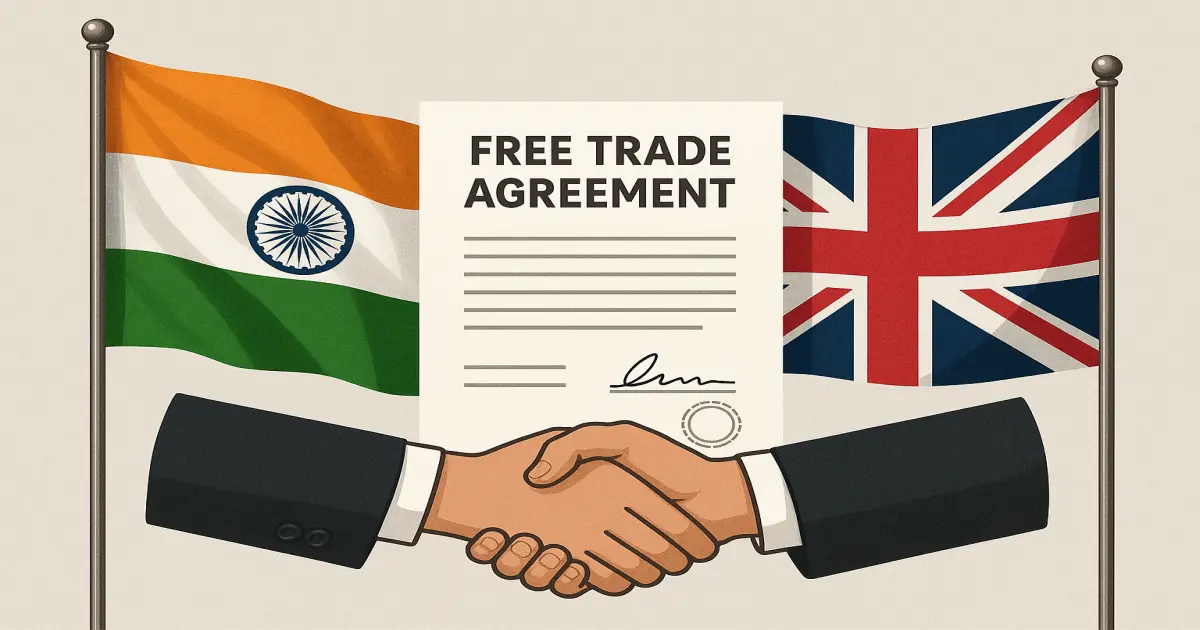India–UK FTA: India and the United Kingdom are entering a new phase in their bilateral and trading relations. Both nations are set to officially sign a Free Trade Agreement (FTA), marking a significant milestone in their long-standing partnership. This agreement is expected to open new doors for economic growth, streamline trade, and enhance cooperation across multiple sectors.
Negotiations for the India–UK FTA began in 2022, with several rounds of meetings held between both countries. Throughout this process, former UK Prime Ministers Boris Johnson and Rishi Sunak played pivotal roles. Their leadership contributed to steady progress in discussions, paving the way for a major trade breakthrough.
India and the UK share a diverse trade relationship, ranging from petroleum products and garments to whisky and various commodities. The total trade between the two countries stands at nearly $23 billion. In recent times, India’s exports to the UK have increased from $12.9 billion to $14.5 billion, reflecting a positive trend.
This growth indicates a strengthening partnership that will likely lead to reduced tariffs and increased trade volumes, benefiting both economies
Key Provisions and Sectoral Impact
As part of the deal, India is expected to lower tariffs on products like whisky and other goods, which is likely to provide a significant advantage to UK exporters—especially in the whisky sector. In return, Indian sectors such as garments, jewellery, and petroleum products are expected to benefit substantially.
The reduction in duties will enhance the competitiveness of Indian goods in the UK market, helping exports reach new heights.
India–UK FTA – India’s Export to the UK
In the financial year 2025, India exported nearly $14.5 billion worth of goods to the UK. Key export items included:
Telecom instruments – $1.5 billion
Petroleum products – $1.3 billion
Iron and steel – approximately $500 million
Ready-made garments (RMG) from cotton, man-made fibres, and other textiles – around $900 million
With reduced tariffs under the India–UK FTA, these figures are expected to grow further. India currently competes with countries like Bangladesh and China in the UK textile market. Lower tariffs could give Indian exporters a competitive edge, especially in the cotton and textile sectors.
India–UK FTA – UK’s Exports to India
The UK, on the other hand, exported goods worth $8.6 billion to India in FY25. Key items included:
Silver – $2.1 billion
Alcoholic beverages – $356.43 million
Aluminium and aluminium products – $383 million
Telecom instruments – $145 million
This two-way trade flow underlines the deep economic connection between the two nations, which is set to strengthen further under the FTA.
India–UK FTA is one of India’s most significant trade agreements with a European country. Moreover, India is also in advanced discussions with the European Union, Switzerland, and the European Free Trade Association (EFTA) for similar agreements.
If signed, these deals could dramatically boost India’s trade presence across Europe and diversify its global export portfolio.
The announcement of PM Modi’s UK visit and the progress in trade talks had a visible impact on the stock market. Tata Motors shares surged by nearly 2%, as the company earns around 13% of its revenue from the UK. Its Land Rover division continues to perform well in the British market. Companies from the garment and petroleum sectors also stand to gain, as the FTA will simplify and accelerate cross-border trade.
The India–UK Free Trade Agreement signifies more than just economic cooperation—it marks the beginning of a deeper, strategic partnership between two influential democracies. As tariffs drop and trade expands, both nations are expected to experience long-term economic benefits. With additional FTAs under discussion with other European nations, India is well on its way to becoming a global trade powerhouse

1 thought on “A new era in India‑UK relations begins as PM Modi is set to sign the India–UK FTA”